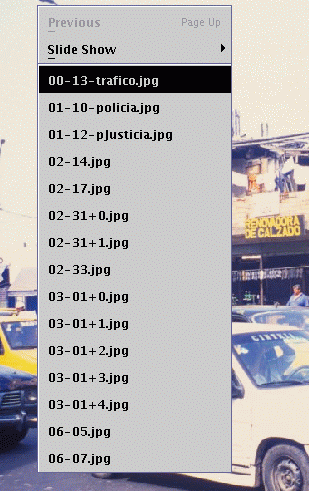| integer |
delay for animated slides (milliseconds) |
| turn angle |
turn image clockwise (angle=90),
anticlockwise (angle=-90) or back (angle=180).
Only integer multiples of 90 are allowed.
Note that this option is set automatically when you use the
Turn Left/Right menu items or their keyboard shortcuts.
|
| mirror |
swap left and right
Note that this option is set automatically when you use the
Mirror menu item or its keyboard shortcut.
|
| playau filename |
play an audio file |
| playau * |
play audio sample stored in the JPEG
Note that this option can also be activated using Audio Finder.
|
| stopau |
stop playing audio when slide changes |
| audio |
image file contains an audio sample
Note that Audio Finder automatically checks and sets this
property. |
| hilit v CIRCLE x y r w rgb |
circle for highlighting a point,
v: A = always visible, M = visible only when mouse is over
the circle,
x, y: coordinates of the center,
r: radius,
w: thickness (floating point number),
rgb: color as a 6-digit hexadecimal number |
| f:[format:]function=formula |
function definition(s) for View Pointer Position mode,
to print in the specified (printf-like) format
Note that the definition(s) must not contain spaces.
Useful to read latitudes and longitudes from a map if
the transformation is known. Example:
KangriGarpo-map.png f:%.4f:lat=29.25+(y-541)*(29.5-29.25)/(271-541) f:%.4f:lon=96.25+(x-272)*(96.75-96.25)/(810-272)
If only the two special function names "lat" and "lon" are used
(in this order!), then coordinates of points selected by clicking
are saved into a file in GPX <wpt> format.
|
gf Next time .
| automatic slide change
time is in s or ms.
|
gf FadingImage "file" x y
[t0=...] [t1=...]
[t2=...] [t3=...] . |
image fade in/out effect
file: image file name,
x, y: coordinates of the top left corner,
t0: start time (s or ms),
t1: fade-in time (s or ms),
t2: display time (s or ms),
t3: fade-out time (s or ms).
Note that in the t2=t3=0 special case, the image
does not fade out and disappear.
|
gf PanoramaScroll dir
[tI=...] [tS=...] [tO=...] . |
panorama scrolling
dir: scrolling direction (L = left to right, R = right to
left, T = top to bottom, B = bottom to top),
tI: zoom-in time (s or ms),
tS: scrolling time (s or ms),
tO: zoom-out time (s or ms).
|
gf Text "text" x y
align [fh=...]
[font=...] [rgb=...] [bg=...]
[t0=...] [t1=...] [t2=...]
[t3=...] . |
text effect
text: string that may contain characters escaped by
backslash, for example \" (quotation mark), \\ (backslash),
\u00e1 (unicode character code),
x, y: coordinates,
align: alignment, vertical (first character:
L, C or R) and horizontal (second character:
T, C or B),
fh: font height (in image pixels),
font: font name and style, use
name for regular font, name-B for bold,
name-I for italic or name-BI for bold italic,
rgb: color as a 6-digit hexadecimal number,
bg: background color (RGB or ARGB) as a 6- or 8-digit
hexadecimal number,
t0: start time (s or ms),
t1: fade-in time (s or ms),
t2: display time (s or ms),
t3: fade-out time (s or ms).
Note that in the t2=t3=0 special case, the text
does not fade out and disappear.
|
| gf Zoom x0=... y0=... s0=wxh . |
zoom to specified area
x0, y0, s0: center and size of the area.
The width w and the height h is a number (pixels),
the character M (maximum) or F (fit to screen size or the other
dimension).
|
gf Zoom [t0=...] [t1=...]
[x0=...] [y0=...] [s0=wxh]
[x1=...] [y1=...] [s1=wxh] . |
zoom-out effect
t0: time to wait before zooming,
t1: zooming time,
x0, y0, s0: center and size of initial area,
x1, y1, s1: center and size of final area.
The width w and the height h is a number (pixels),
the character M (maximum) or F (fit to screen size or the other
dimension).
|
| stop |
stop playing slide show at this point |
| xf XF ttotal [e=...] |
cross-fade effect
ttotal: transition time,
e exponent (default: 1)
The alpha value of the new image at time t after the start
of effect is
α(t) = (t / ttotal)e,
where the exponent must be positive: e>0.
|
| xf ZoomXF x y ttotal [e=...] |
zoom transition effect combined with cross-fade
x, y: coordinates of the center,
ttotal: transition time,
e exponent (default: 1) |
| xf Zoom x y ttotal |
simple zoom transition effect
x, y: coordinates of the center,
ttotal: total time |
| align
x1 y1
x2 y2 |
alignment points |

